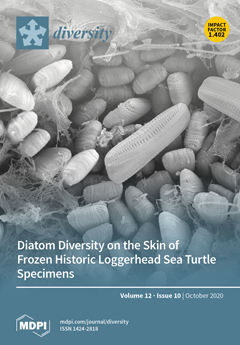Parrotfish provide important ecological functions on coral reefs, including the provision of new settlement space through grazing and the generation of sediment through bioerosion of reef substrate. Estimating these functions at an ecosystem level depends on accurately quantifying the functional impact of individuals,
[...] Read more.
Parrotfish provide important ecological functions on coral reefs, including the provision of new settlement space through grazing and the generation of sediment through bioerosion of reef substrate. Estimating these functions at an ecosystem level depends on accurately quantifying the functional impact of individuals, yet parrotfish feeding metrics are only available for a limited range of sites, species and size classes. We quantified bite rates, proportion of bites leaving scars and scar sizes in situ for the dominant excavator (
Cetoscarus ocellatus, Chlorurus strongylocephalus, Ch. sordidus) and scraper species (
Scarus rubroviolaceus, S. frenatus, S. niger, S. tricolor, S. scaber, S. psittacus) in the central Indian Ocean. This includes the first record of scar frequencies and sizes for the latter three species. Bite rates varied with species and life phase and decreased with body size. The proportion of bites leaving scars and scar sizes differed among species and increased with body size. Species-level allometric relationships between body size and each of these feeding metrics were used to parameterize annual individual grazing and bioerosion rates which increase non-linearly with body size. Large individuals of
C. ocellatus, Ch. strongylocephalus and
S. rubroviolaceus can graze 200–400 m
2 and erode >500 kg of reef substrate annually. Smaller species graze 1–100 m
2 yr
−1 and erode 0.2–30 kg yr
−1. We used these individual functional rates to quantify community grazing and bioerosion levels at 15 sites across the Maldives and the Chagos Archipelago. Although parrotfish density was 2.6 times higher on Maldivian reefs, average grazing (3.9 ± 1.4 m
2 m
−2 reef yr
−1) and bioerosion levels (3.1 ± 1.2 kg m
−2 reef yr
−1) were about 15% lower than in the Chagos Archipelago (4.5 ± 2.3 and 3.7 ± 3.0, respectively), due to the dominance of small species and individuals in the Maldives (90% <30 cm length). This demonstrates that large-bodied species and individuals contribute disproportionally to both grazing and bioerosion. Across all sites, grazing increased by 66 ± 5 m
2 ha
−1 and bioerosion by 109 ± 9 kg ha
−1 for every kg increase in parrotfish biomass. However, for a given level of parrotfish biomass, grazing and bioerosion levels were higher on Maldivian reefs than in the Chagos Archipelago. This suggests that small-bodied fish assemblages can maintain ecosystem functions, but only if key species are present in sufficiently high numbers.
Full article





